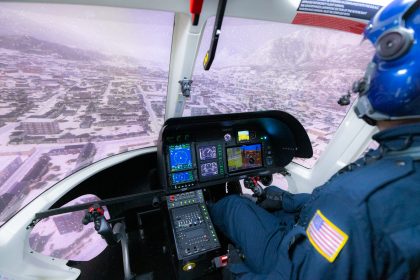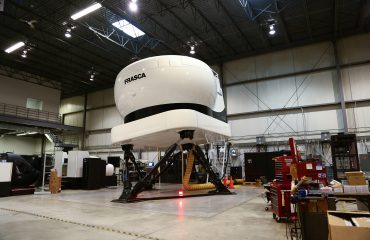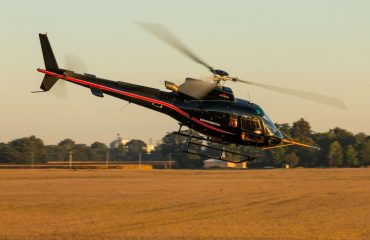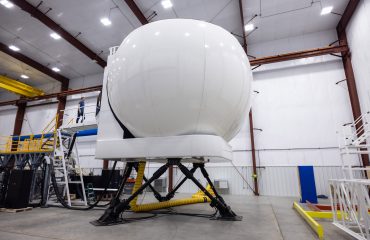
Despite affordable rotorcraft simulator solutions on the market today, many helicopter pilots learn to fly exclusively in the helicopter. However, for obvious safety reasons, aircraft-only training does not allow for realistic simulated emergencies. Instead, pilots simulate emergency procedures in the aircraft by talking through the steps and touching switches rather than actuating them. They are also not experiencing or seeing realistic cues present in a true emergency. Unfortunately, when an emergency occurs, the transfer of knowledge to a real response does not fully transfer and accidents are not avoided.
Similarly, training in the aircraft does not allow pilots to fully experience the results of their decision making throughout the flight. Training flights are not going to be performed in questionable weather, under stress to complete the flight, or at potentially unsafe altitudes if an engine should fail.
In a simulator, however, the actual full situations and emergency scenarios can be fully simulated. Instructors can pause mid-action to provide immediate feedback or correction. Flights can also play out completely, allowing pilots to experience the results of their decisions throughout the flight for a deeper learning experience. Experiencing the consequences of decisions, whether good or bad, helps improve aeronautical decision making and offers pilots a realistic situation to consider what could have been done differently.
Additionally, simulators allow pilots to practice the same maneuver multiple times in rapid succession; there’s no need to circle back to reposition the aircraft. Instruments, visual cues, vibration, and control feedback provide realistic experiences that help develop muscle memory for faster recognition and correct reaction.
In 2014, in response to continued accidents in the helicopter industry, the NTSB released safety alert SA-031 recommending simulator training for helicopter pilots. The safety alert highlighted the NTSB’s belief that training in approved simulators could have increased pilots’ skill in handling in-flight emergencies and avoided maneuver errors. The alert noted “consistent, standardized simulator training will help prepare pilots for the unexpected and will decrease the risk of an accident.”
At the same time, vastly improved computer simulation and graphics led to increased development in flight training devices (FTDs), which are far less expensive to own and operate than aircraft or larger full flight simulators (FFS). FTDs are simulators that can emulate a specific aircraft or several with one device. While they typically do not move, though some offer motion cueing, they provide accurate instrument responses and flight controls to properly learn, practice, and build correct muscle memory for scenarios at a much lower cost than a full motion simulator or the aircraft.
Frasca has worked alongside numerous aircraft manufacturers to provide realistic experiences for pilots, from installing actual equipment and controls in simulators that mirror those in the aircraft to programming the simulator to respond exactly how the aircraft would in any scenario. The result is a highly realistic flight simulation environment that provides the perfect platform for scenario-based-training at a significant cost savings compared to training in an aircraft.
Simulator manufacturers, including Frasca, also worked with the FAA to achieve approval for simulator use toward minimum requirements for ratings, certificates, and recurrency. As a result, many operators now use FTDs in their training and recurrency programs.
FTDs at Work
Frasca customer Med-Trans Corporation of Denton, Texas, operates a Frasca Bell 407GX Level 7 FTD, providing each pilot annual training in it annually. While the company used to outsource simulator flight training, it determined the value of the training with the higher fidelity options from Level 7 FTDs, which include motion cueing, costs a fraction of the expense of sending pilots to a third-party full flight simulator training facility.
“We are absolutely happy with the device,” Med-Trans Corporation Director of Operations Mike LaMee told HAI’s ROTOR Magazine in 2021. “You can’t simulate an engine fire or get engine gauges to show oil temp high or loss of oil pressure in an aircraft. With a simulator you can. It goes beyond learning emergencies academically. You can see the real indications you would experience in a situation. We’ve gotten overwhelmingly positive feedback from our pilots.”
The cost savings of operating an FTD is multi-faceted. Operators save on insurance, travel costs, wear and tear on aircraft, and aircraft operating costs. Training flights have also led to accidents and incidents with significant aircraft damage. Operators using simulators for training can avoid unintentional aircraft damage during training, not to mention avoiding lost income when an aircraft is not available for work due to training or repairs of training-related damage.
Resources for Simulator Training
In 2020, the United States Helicopter Safety Team (USHST) released recommended practices for simulation training in aviation decision making, highlighting key accidents it felt could be avoided if pilots practiced the scenarios realistically in a simulated training environment. The team specifically calls out that FTDs “provide the appropriate level of fidelity based on programming from actual flight test data, wind tunnel testing results, or engineering data” for this training.
Highlighting the causes of the largest number of accidents, the USHST recommended using simulators to perform scenario-based training to avoid and/or recover from loss of rotor RPM, loss of tail rotor effectiveness (LTE), spatial disorientation, unintended flight into IMC, low altitude wire strike hazards, and low altitude engine failure. The USHST also offers a video highlighting an example of using the simulator this way: Simulation: Learn From Your Mistakes.
With a simulator, students can be exposed to a scenario that unfolds naturally from the beginning without instructor intervention, allowing students to experience the results of their own actions and decisions that can lead to these dangerous situations. If the flight ends in a crash, students gain valuable understanding of where in the flight their decisions began leading to the detrimental outcome and walk away with a stronger understanding of the role of aeronautical decision making from before the flight begins to the moment it ends.
Frasca FTDs offer operators the ability to safety, correctly, and economically train pilots how to respond to emergencies and even recognize and avoid potentially dangerous situations such as inadvertent IMC. For a fraction of the cost of training in an aircraft or sending pilots to facilities with expensive full-motion simulators, operators can take control of their own training, costs, and expenses while significantly increasing safety and reducing the risk of avoidable accidents.



